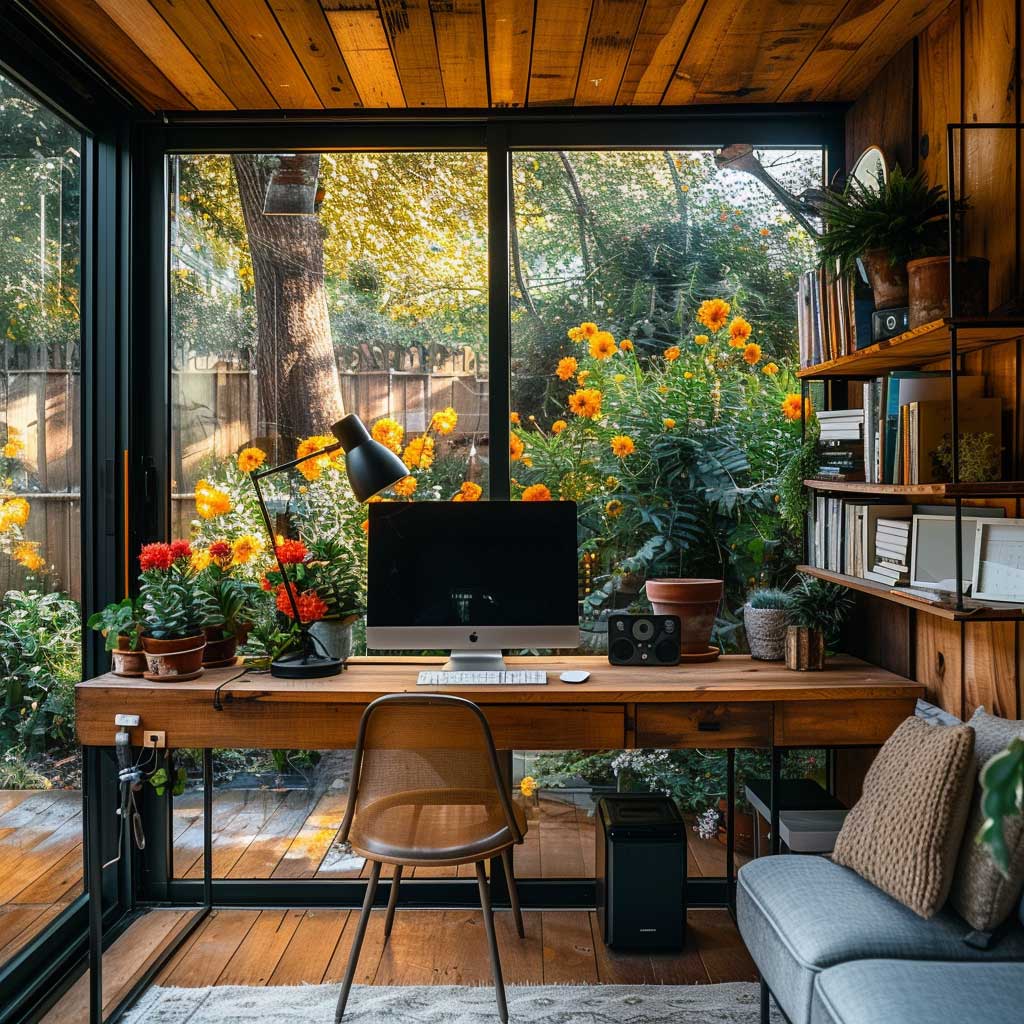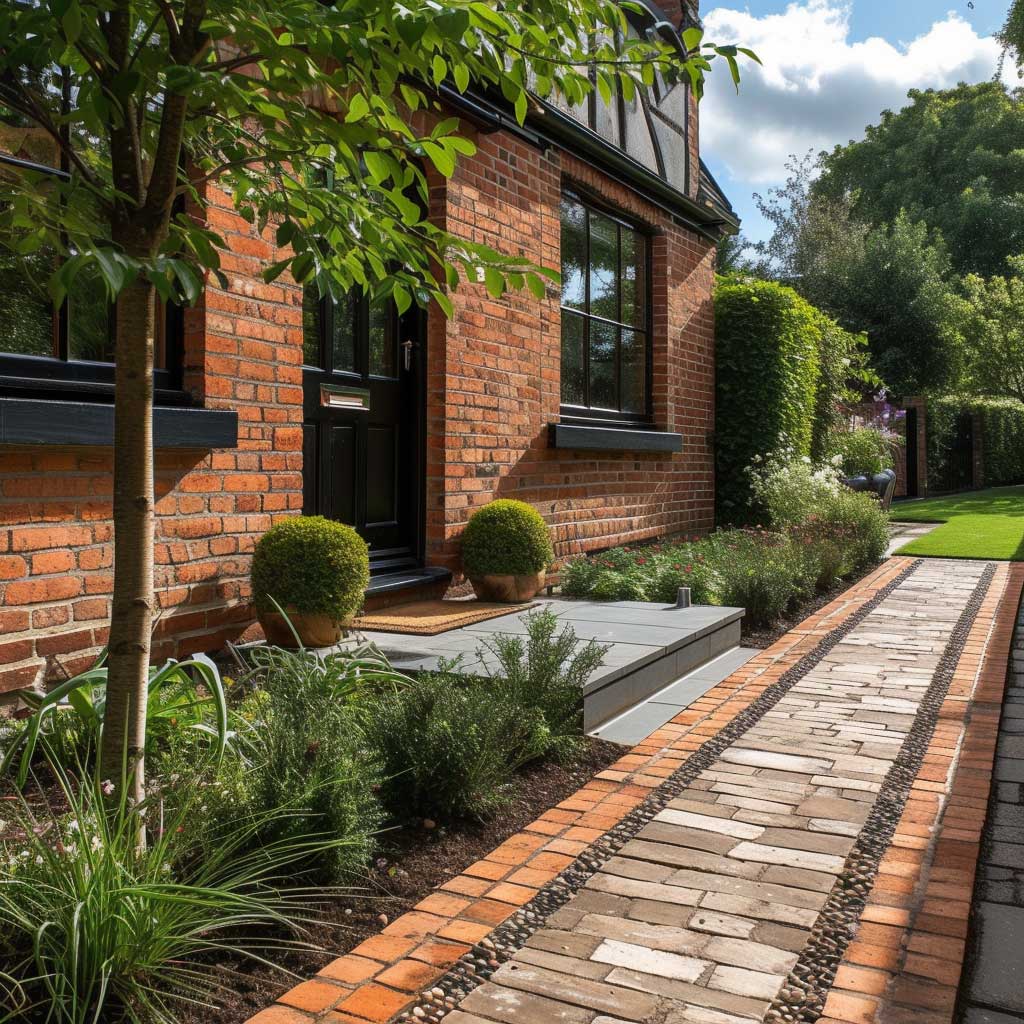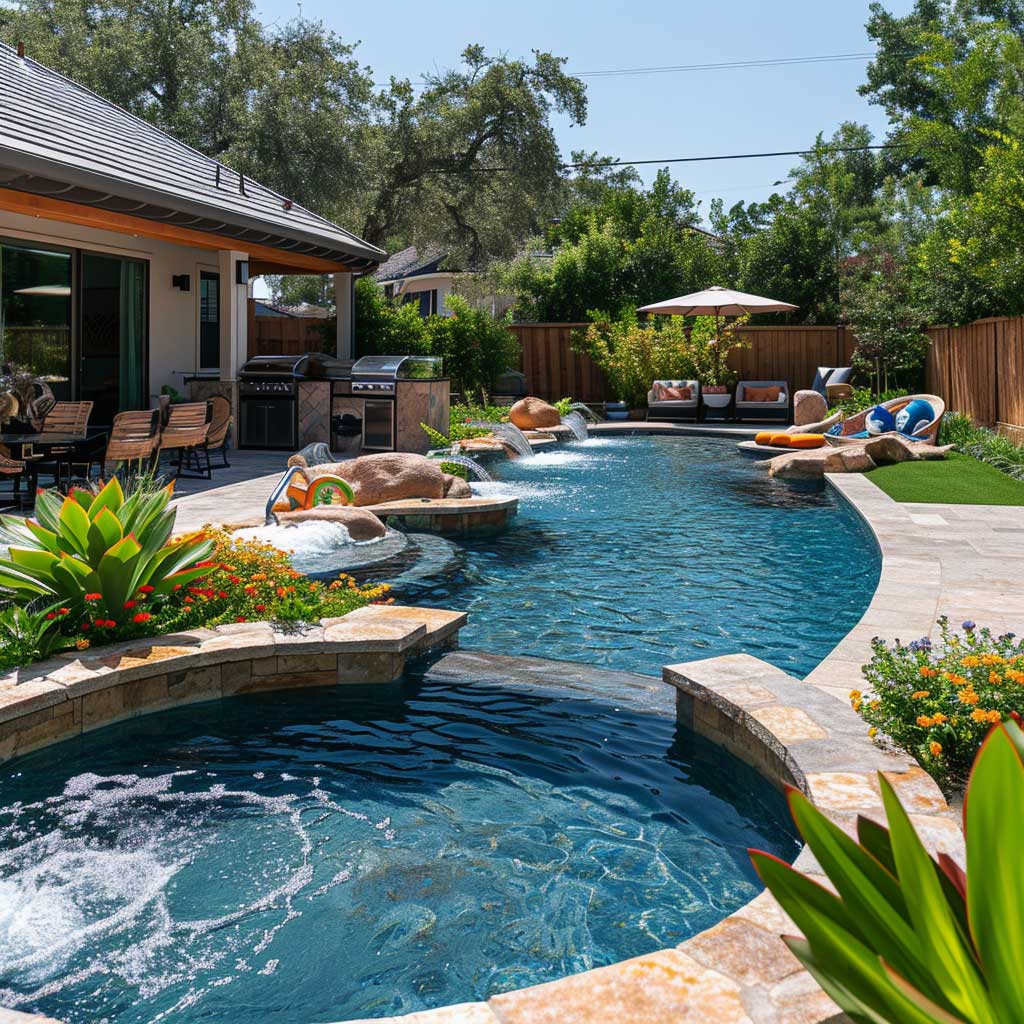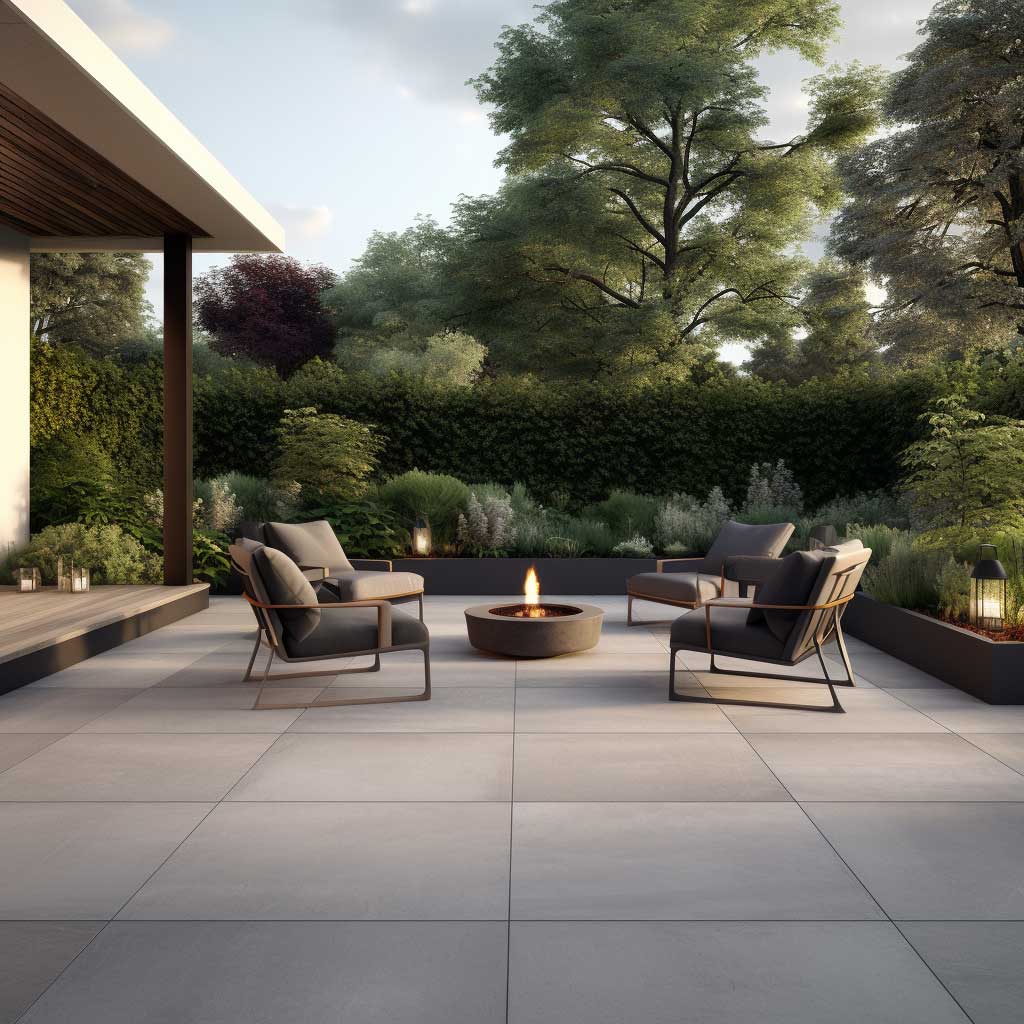In the realm of landscape architecture, the fusion of sculptural elements with modern garden design is a growing trend that merges artistry with the natural environment. This approach not only enhances the aesthetic appeal of outdoor spaces but also creates a unique, immersive experience for visitors. By integrating sculptures into garden designs, landscape architects and designers are able to add depth, texture, and a sense of dynamism to gardens, making them not just areas for relaxation but also spaces for artistic expression.
Whispering Waves in a Serene Garden
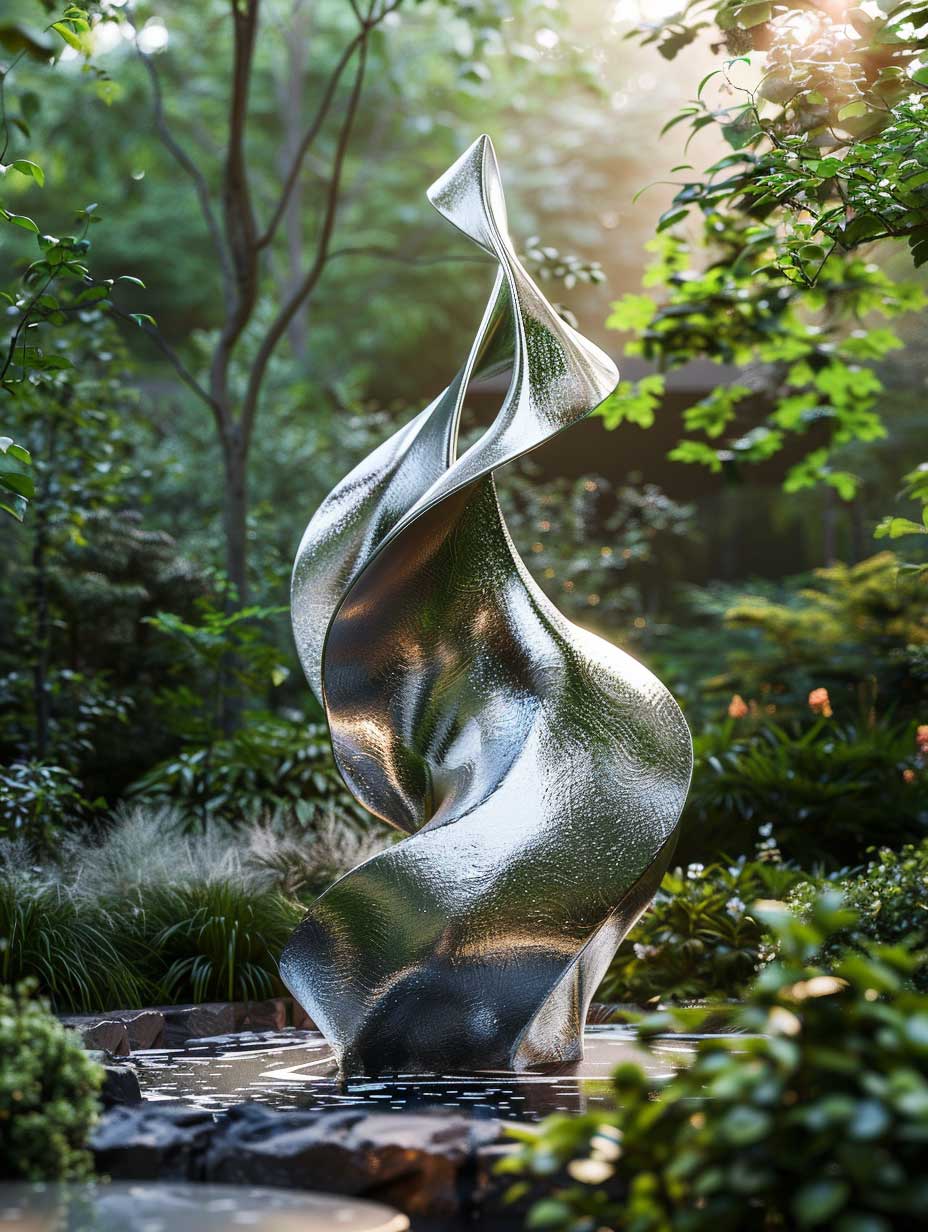
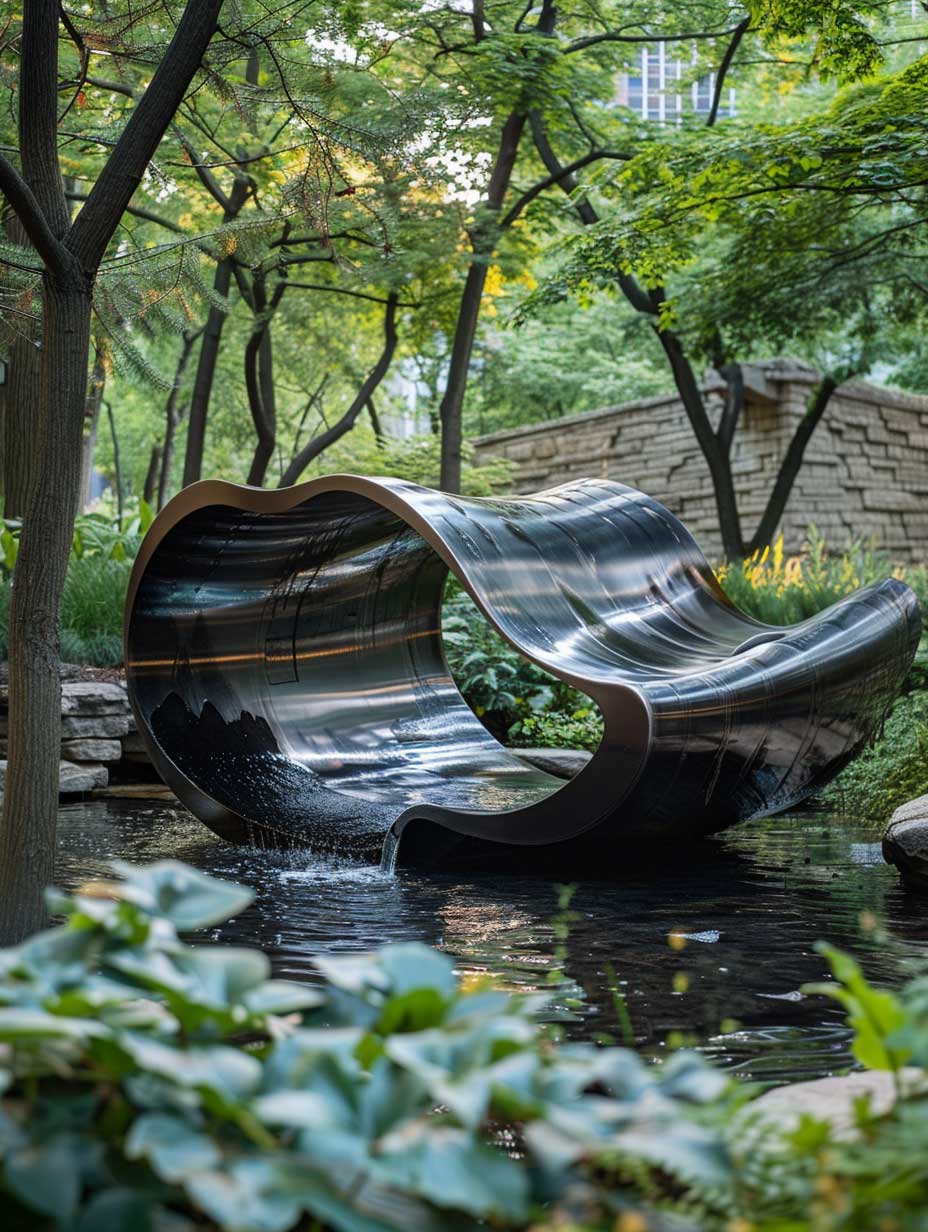

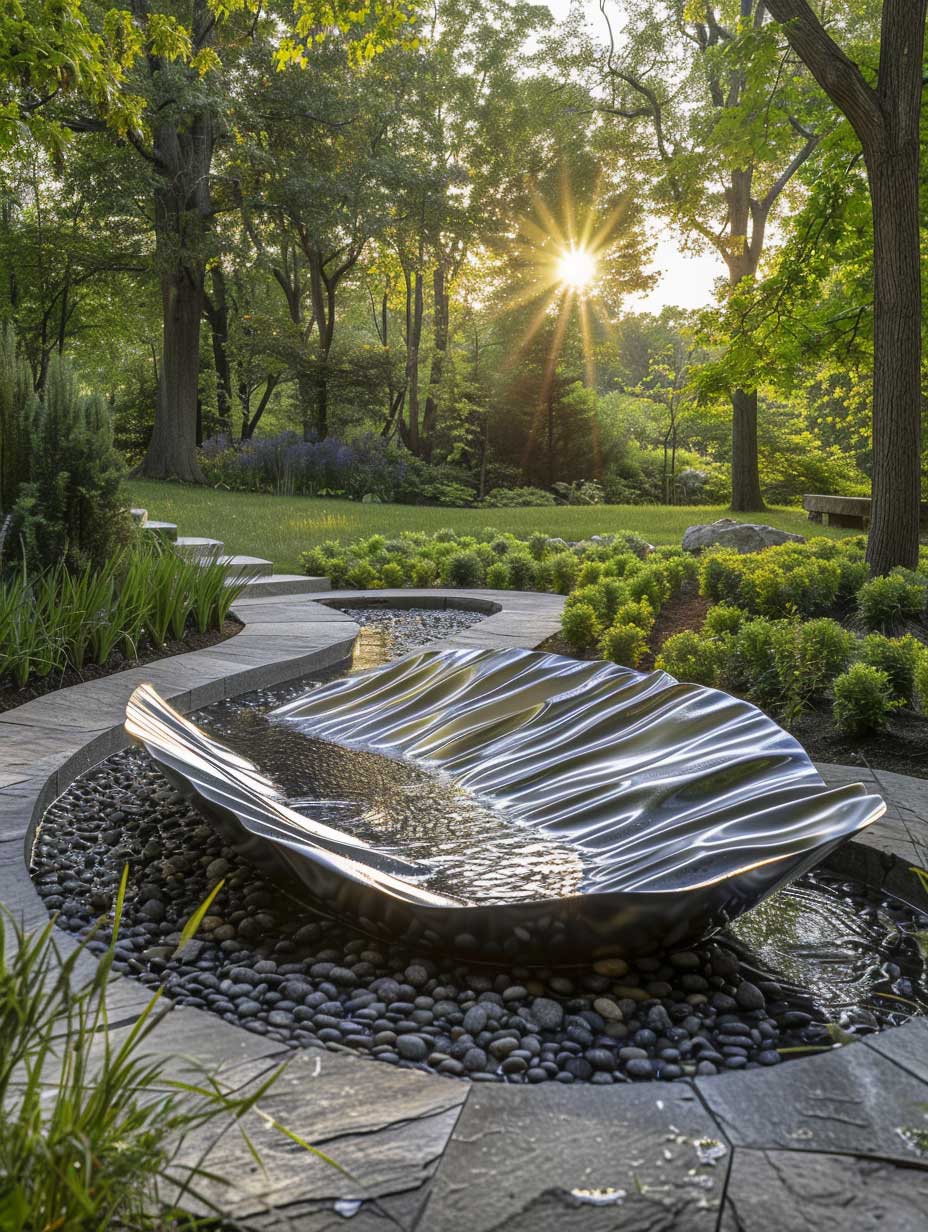
In the heart of a bustling city lies a sanctuary where the essence of modern garden design converges with the timeless beauty of sculptural art. This space, a testament to contemporary landscape architecture, harmonizes the organic with the man-made, creating a dialogue between the elements. At its core, a sculpture that mirrors the gentle undulations of waves stands, crafted with meticulous precision from shimmering metal. This piece, while seemingly simple in its abstraction, is a focal point that draws visitors into a deeper contemplation of nature and design.
The garden, an epitome of modernity, does not conform to the traditional layouts of pathways and flower beds. Instead, it invites an exploration of space and form, where every turn unveils a new perspective of the sculptural waves. These metallic curves, polished to reflect the sunlight, ripple through the air, casting soft shadows on the meticulously manicured grass. The effect is a serene interplay of light and shadow, a visual symphony that changes with the passing day.
Around this central sculpture, the garden unfolds in layers of greenery and floral blooms. Each plant species has been chosen not just for its aesthetic appeal but for its ability to complement the modern ethos of the garden. The landscape architects have envisioned a garden that is both a feast for the senses and a haven for biodiversity. Native plants mingle with exotic species, creating a tapestry of textures and colors that enhance the garden’s contemporary vibe.
The design of the garden emphasizes sustainability, with water-conservation practices integrated into its layout. Rainwater is harvested and used to irrigate the plants, ensuring that the garden remains a lush oasis even in the warmer months. This approach not only aligns with the principles of modern garden design but also serves as a reminder of the importance of living in harmony with our environment.

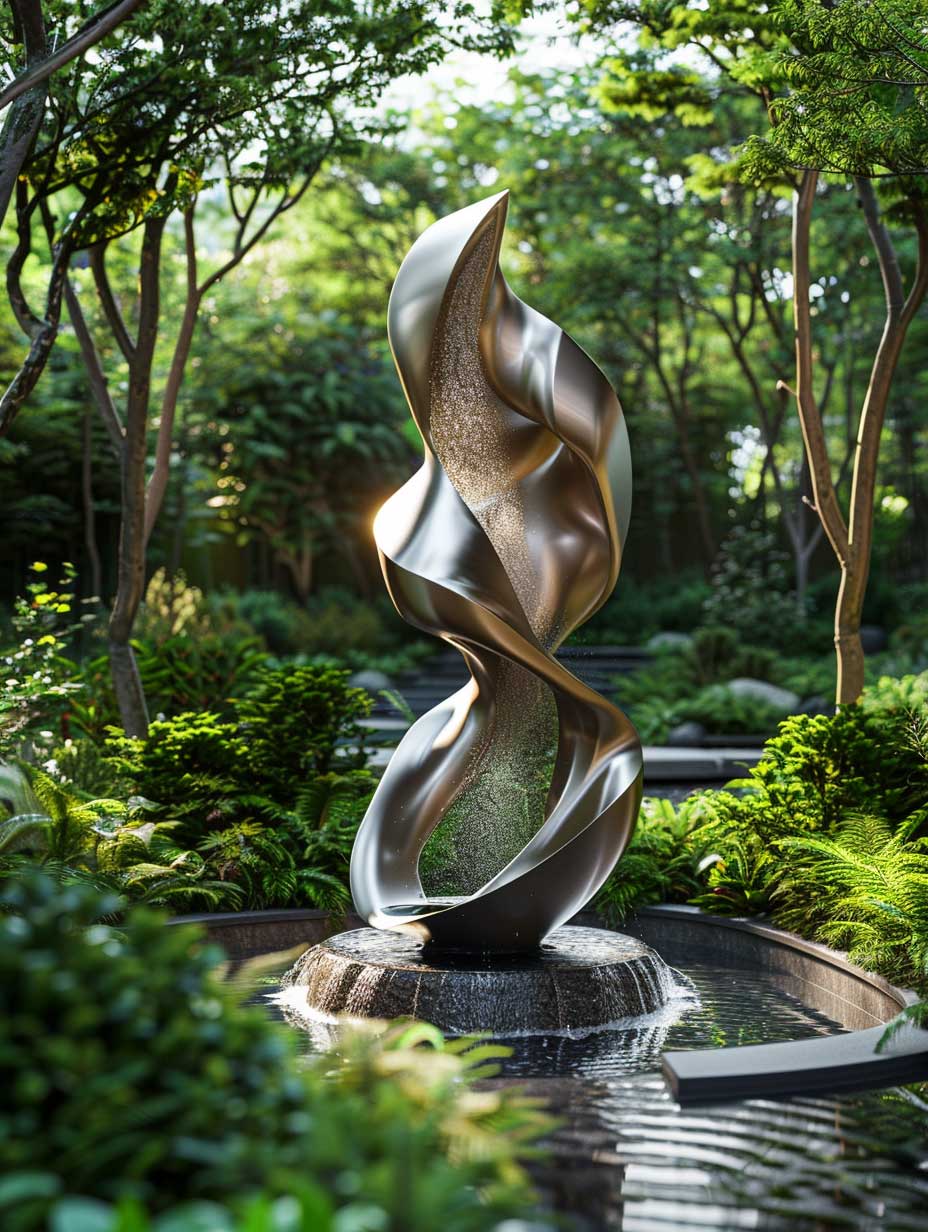
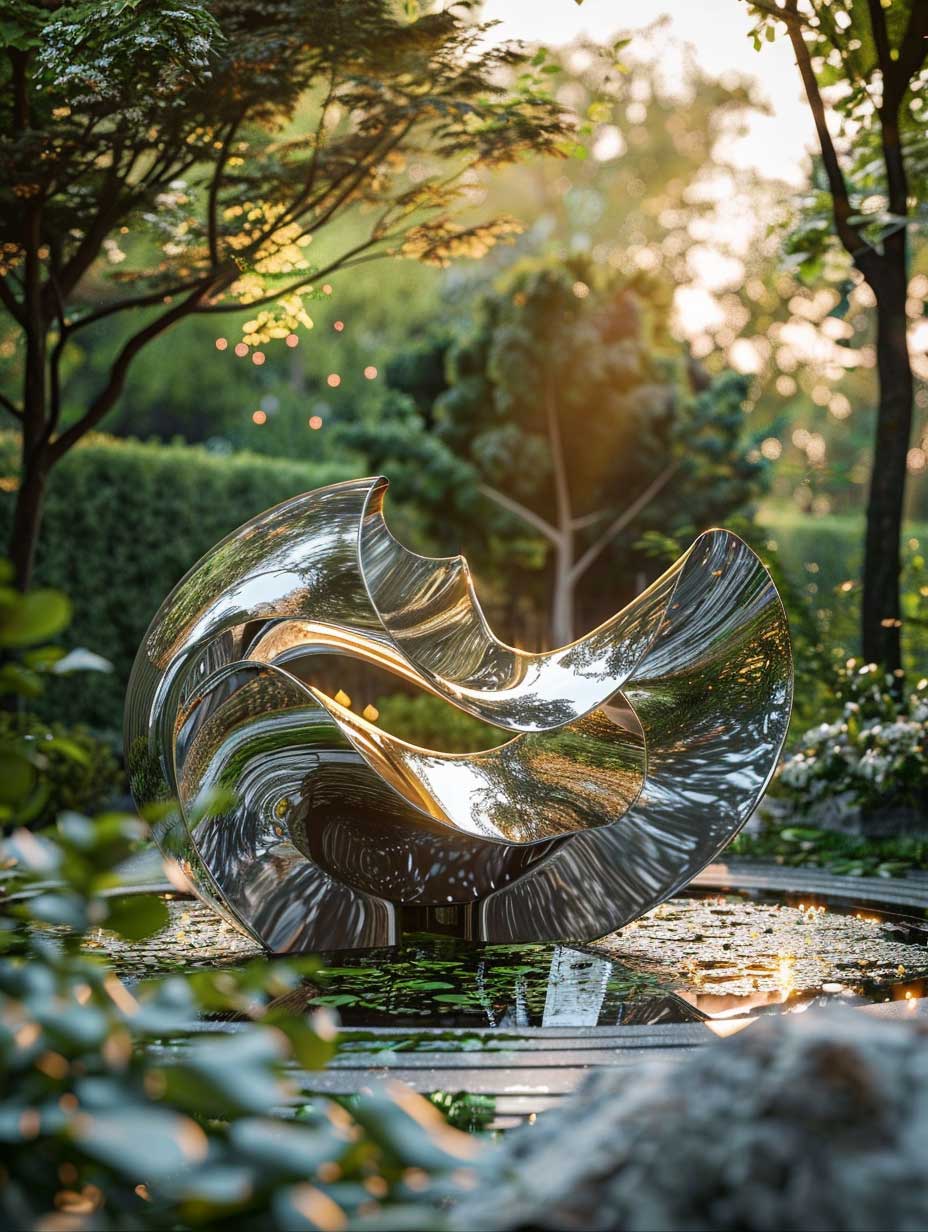

Visitors to the garden are encouraged to slow down and engage with the space. Benches strategically placed near the sculpture offer spots for reflection and relaxation. From these vantage points, one can appreciate the intricate details of the wave sculpture—the way it seems to move, despite its solidity, and how it interacts with the natural elements. This immersive experience is what sets the garden apart, transforming it from a mere outdoor space to a destination where art and nature coalesce.
As the day wanes, the garden takes on a new character. Lighting designed to accentuate the sculpture’s form illuminates the waves, creating a dramatic visual effect. The garden becomes a place of enchantment, where the boundaries between the natural and the artificial blur. It is in these moments that the true genius of integrating sculptural elements into garden design is fully realized.
This garden, with its whispering waves, stands as a beacon of modern garden design. It challenges preconceived notions of what a garden should be, offering instead a space that is innovative, interactive, and introspective. Through the integration of sculpture, it speaks to the power of design to evoke emotion and provoke thought, reminding us that beauty lies in the balance between the crafted and the natural.
Shadows and Light: A Sculptural Dance

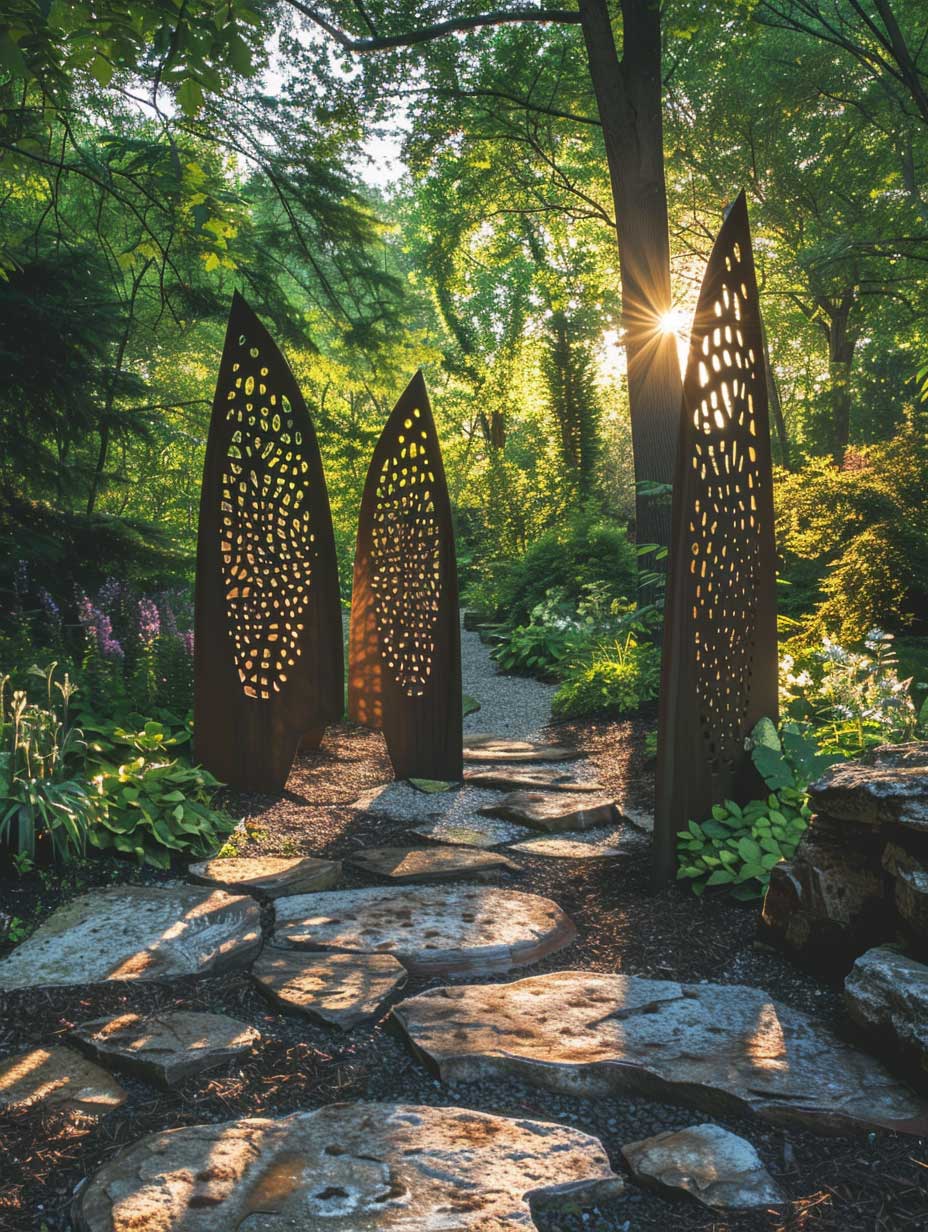
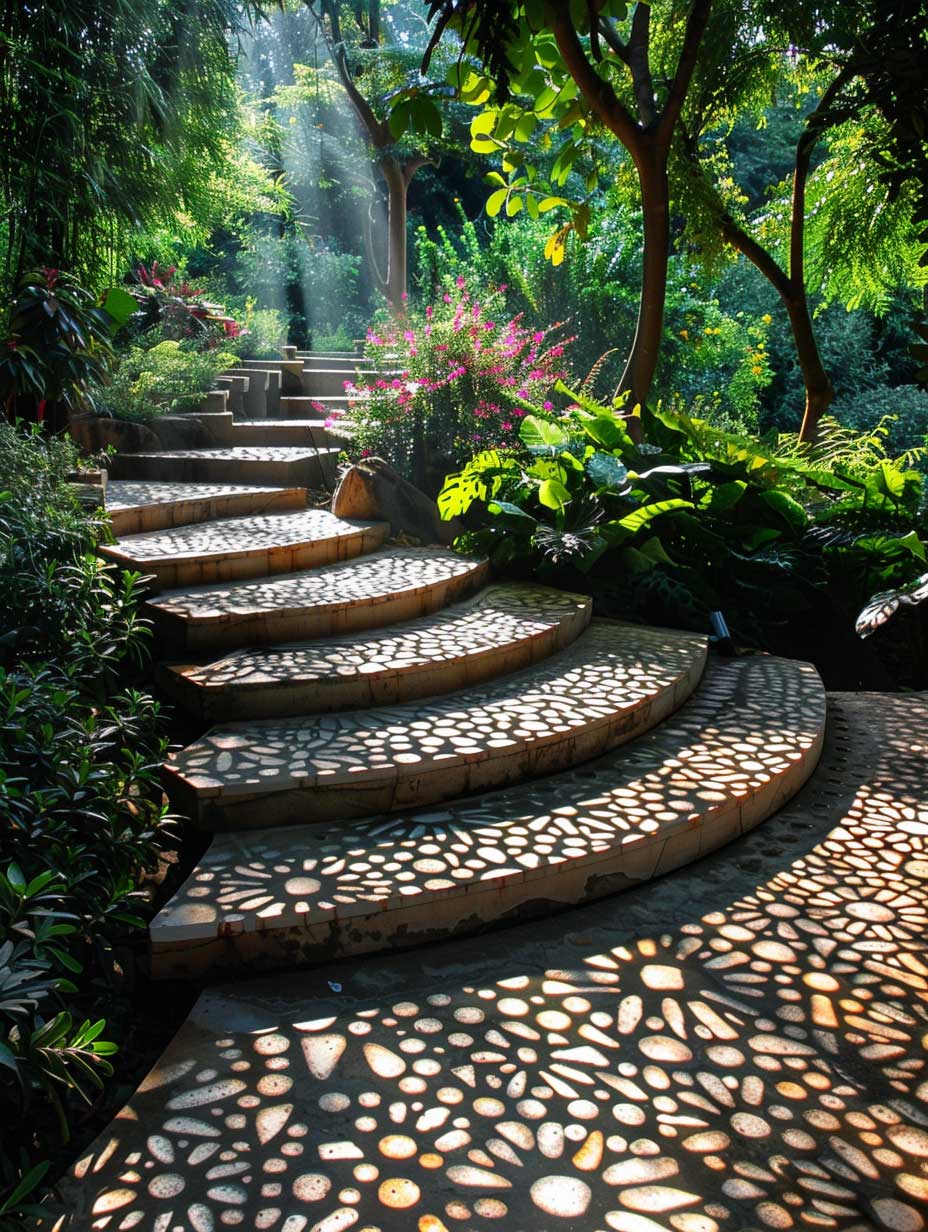
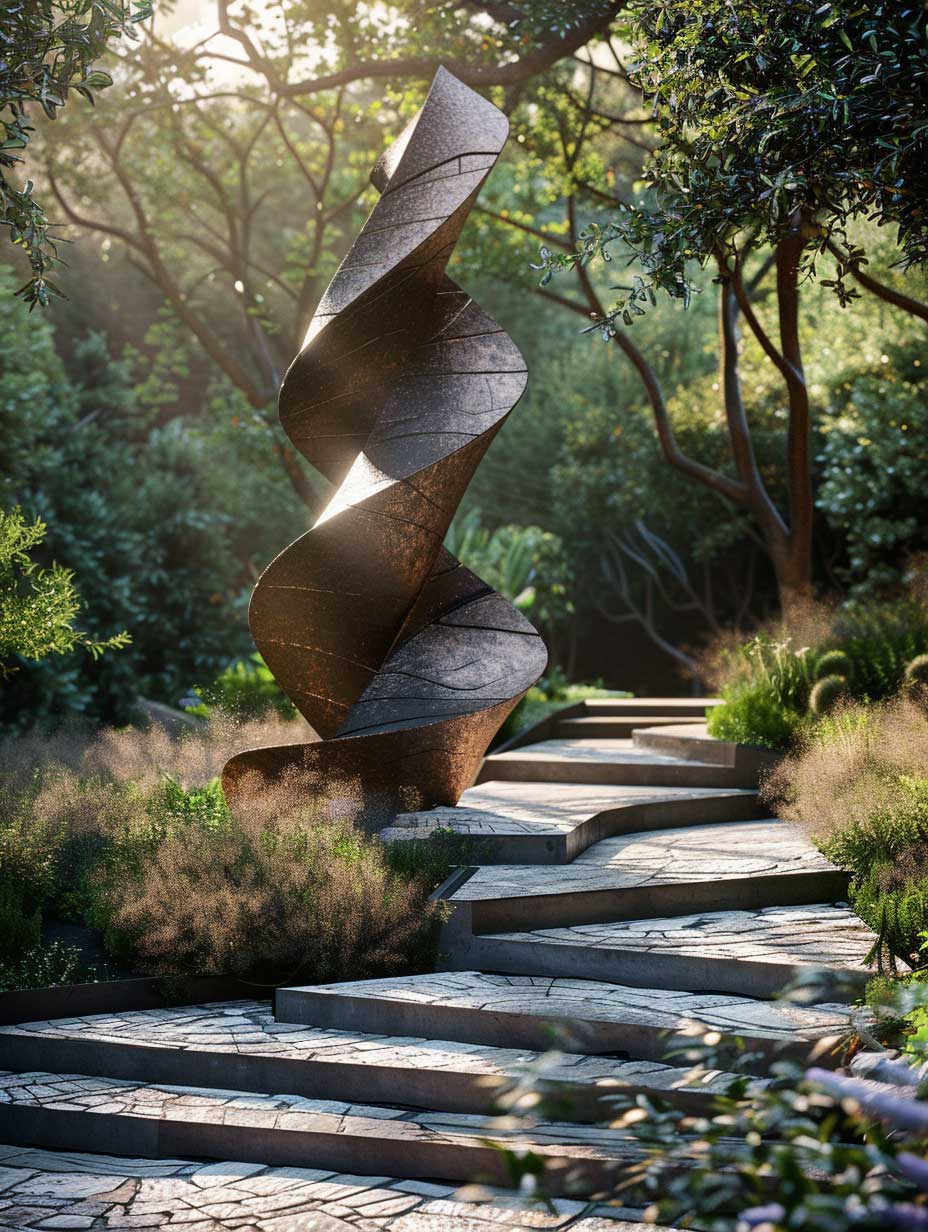
Nestled within a verdant expanse, a garden designed for the modern era becomes a canvas for an extraordinary interplay of shadows and light. This garden transcends the conventional, morphing into a stage where sculptures and sunlight perform a daily ballet, captivating all who wander its paths. At the heart of this spectacle are abstract, geometric sculptures, each a masterwork designed to interact with the light in unique ways, casting intricate patterns on the earth below.
As the sun arcs across the sky, these sculptures transform. Morning light bathes them in a soft glow, highlighting the sharp angles and smooth surfaces of their forms. By noon, their shadows become pronounced, stark against the lush grass, inviting visitors to contemplate the fleeting nature of time and the constant dance of the natural world. As evening approaches, the sculptures seem to soften, their shadows elongating and merging with the landscape, creating a tranquil, almost dreamlike atmosphere.
This dynamic environment is a testament to the vision of its creators, who sought not just to install art within a garden but to craft a space where art and nature are in constant conversation. The choice of materials for the sculptures—metal, stone, and glass—reflects a commitment to durability and sustainability, ensuring that this dialogue continues for generations. Each piece is positioned with precision, considering not only the path of the sun but also the viewing angles that offer the most dramatic interplay of shadow and light.
The design of the garden itself is a modern marvel. Paths wind organically through the space, guiding visitors on a journey that encourages exploration and discovery. Native plants and trees frame the sculptures, their placement intentional, designed to complement the changing light and seasons. Water features add a layer of sound and movement, enhancing the sensory experience of the garden and providing a counterpoint to the static nature of the sculptures.
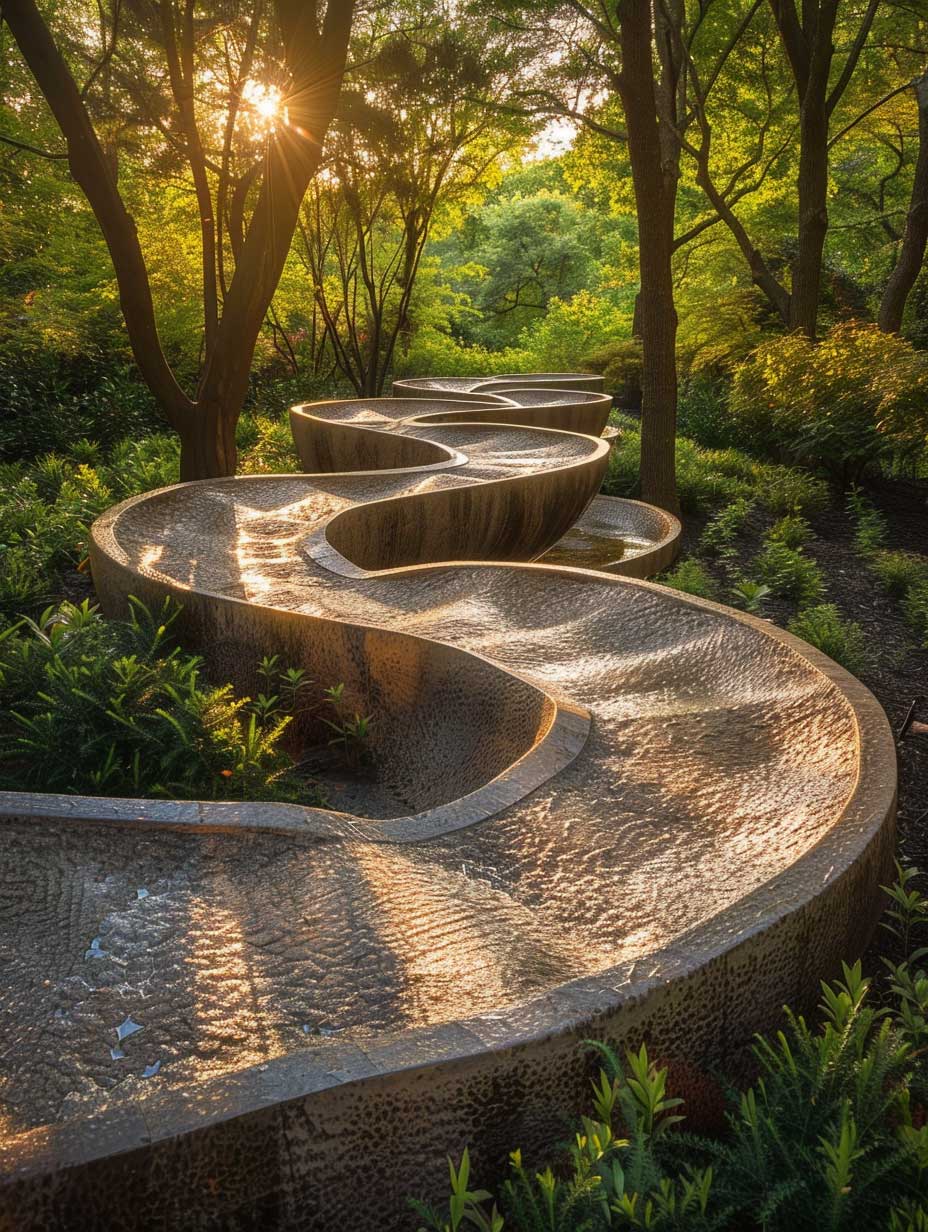
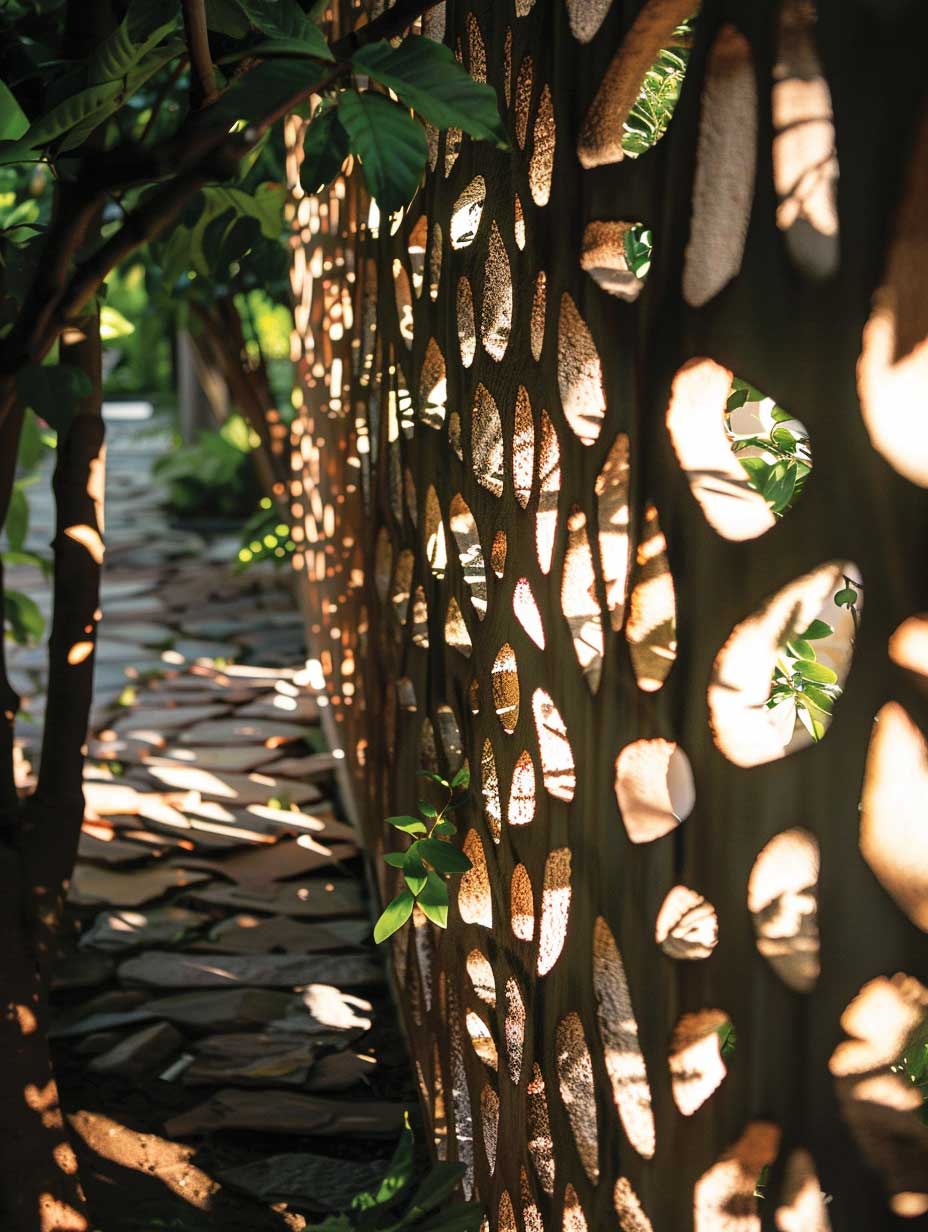


This garden is more than a collection of plants and sculptures; it is a living, breathing entity that evolves with the passage of time. It challenges visitors to see beyond the physicality of its components, to engage with the ephemeral qualities of light and shadow. In doing so, it becomes a space of meditation and introspection, a sanctuary where the boundaries between the self and the surrounding world blur.
Education plays a critical role in the garden’s design, with plaques and interactive guides explaining the concepts behind the sculptures and their interplay with light. Workshops and tours encourage deeper engagement, inviting visitors to learn about the principles of modern garden design, the art of sculpture, and the science of light. Through these educational initiatives, the garden fosters a deeper appreciation for the intricacies of its design and the environmental considerations that underpin its maintenance.
As night falls, artificial lighting takes over, mimicking the natural light of day and ensuring that the dance of shadows and light continues. This nocturnal illumination is carefully calibrated to highlight the sculptures without disrupting the garden’s nocturnal ecosystem, showcasing the thoughtful balance between human artistry and nature’s own creations.
In this garden, shadows and light are not mere byproducts of the sun’s journey across the sky; they are integral to the experience of the space, elements as vital as the sculptures themselves. This garden, a pinnacle of modern garden design, invites us to witness the beauty of transition and transformation, to find joy in the ephemeral and to reflect on the enduring interplay between light and shadow, art and nature.
The Green Maze: A Journey Through Form
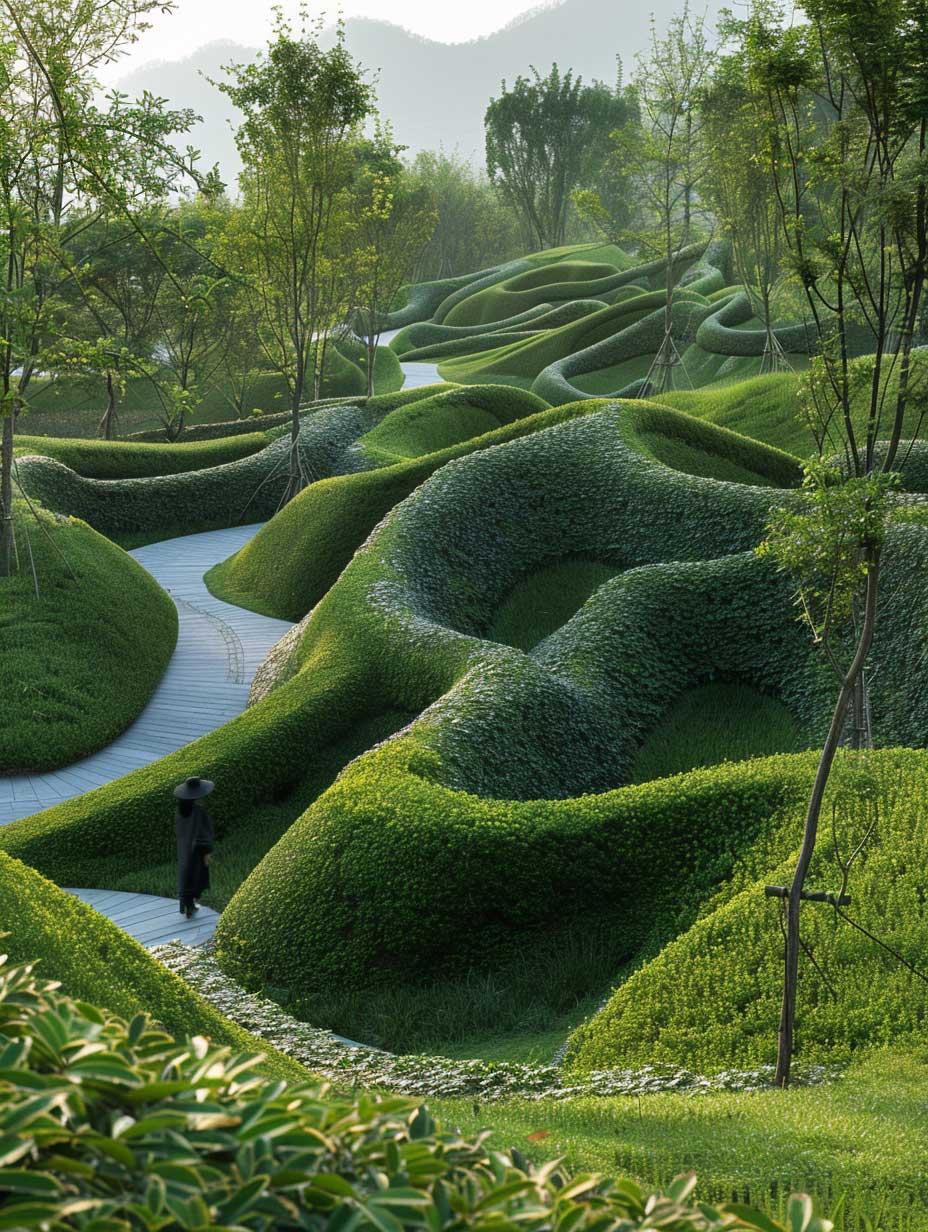
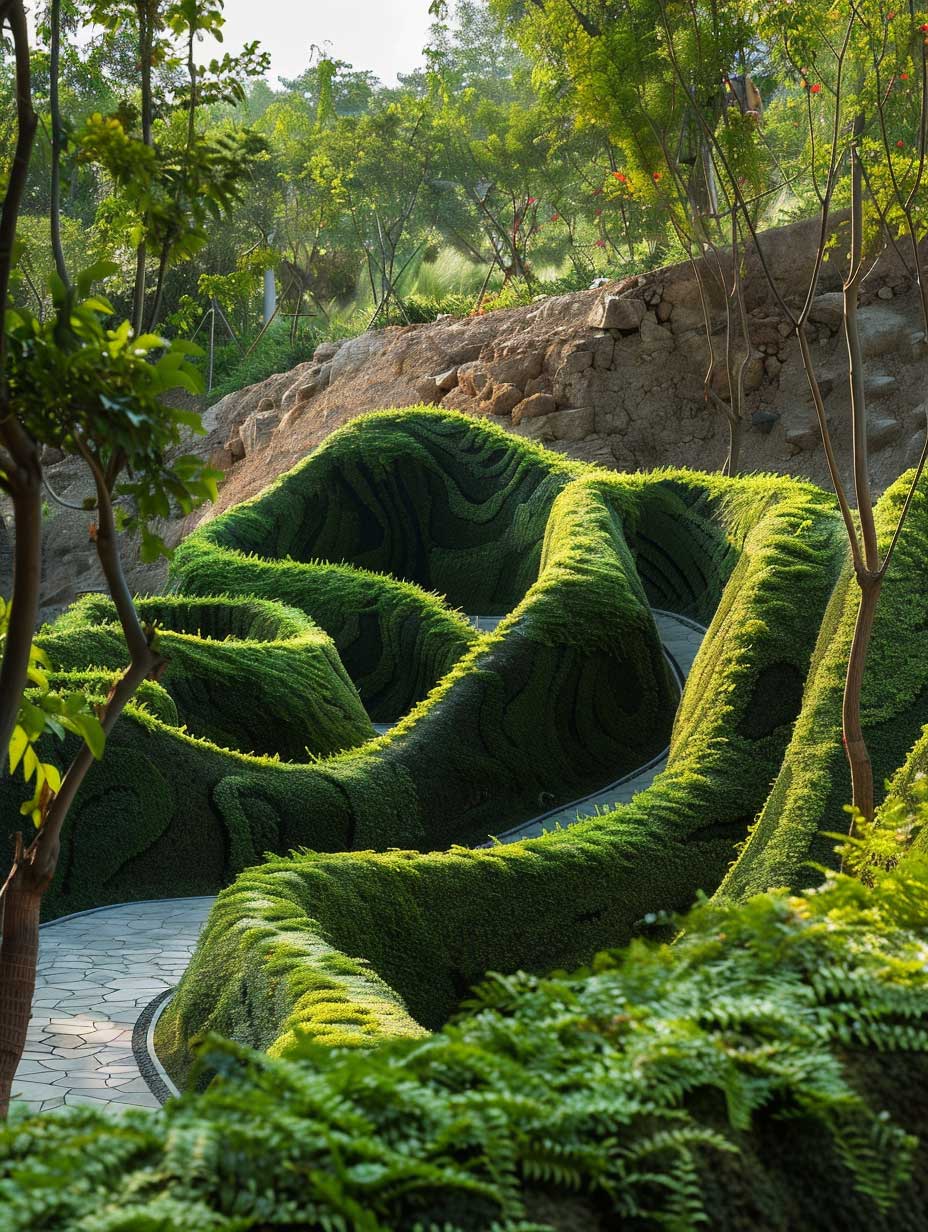
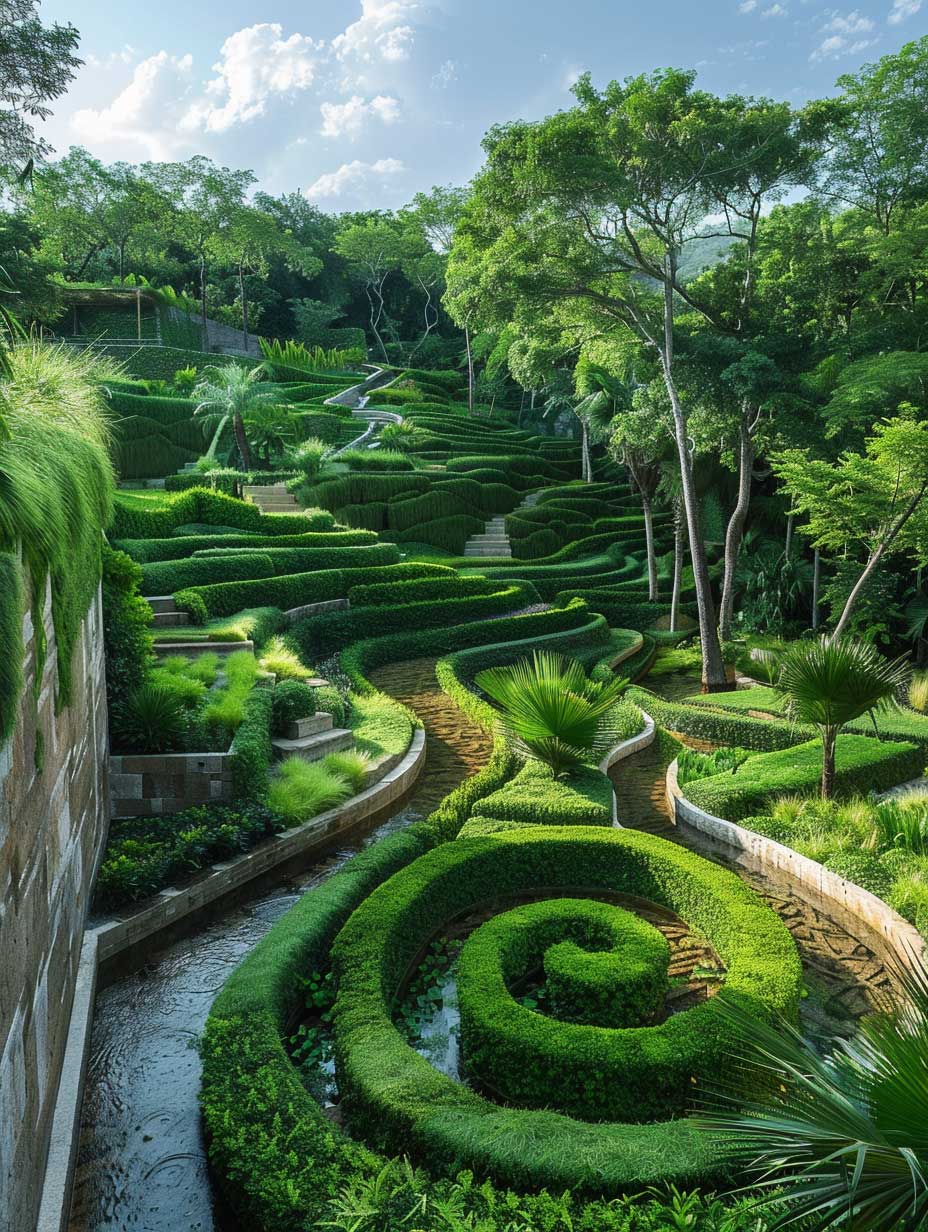
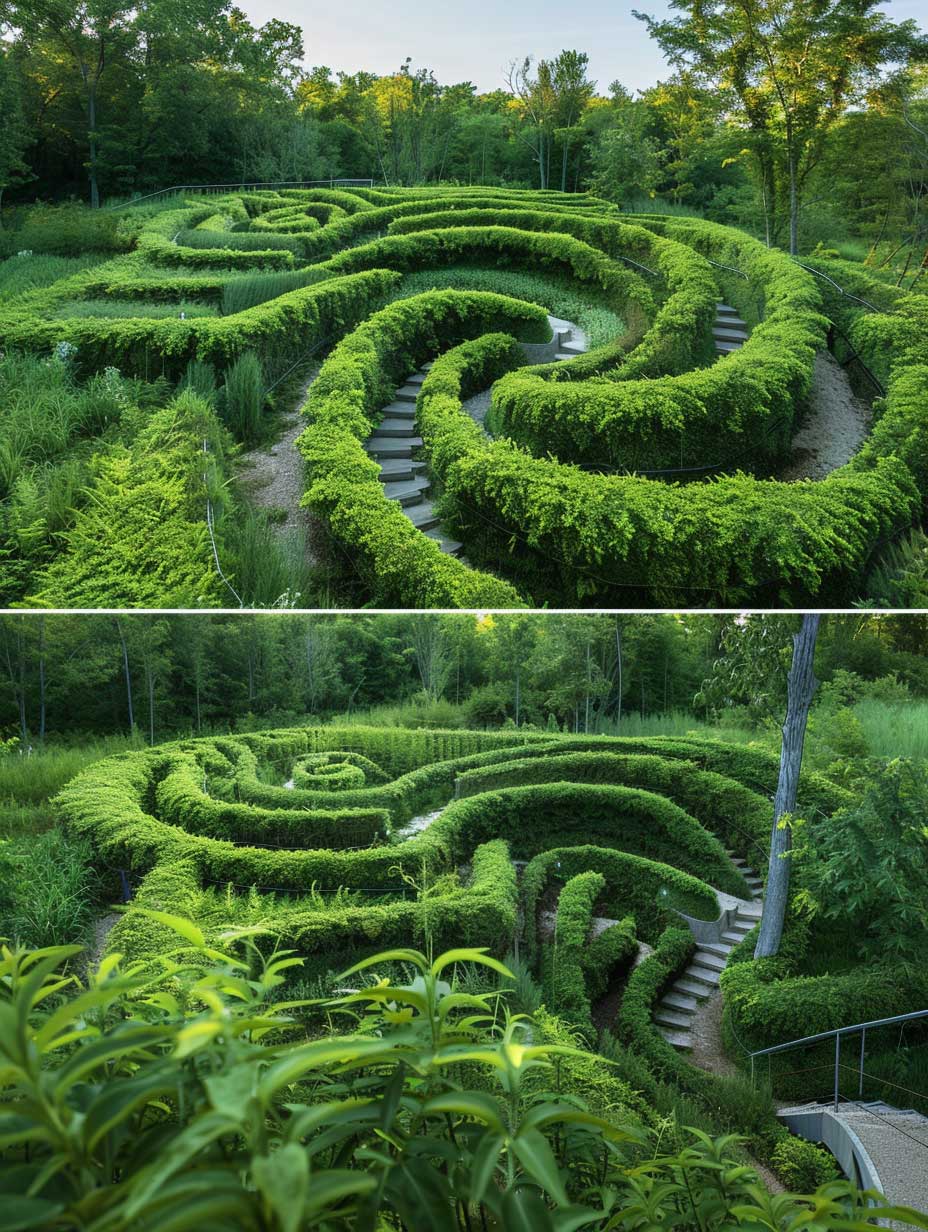
Amidst the evolving landscape of modern garden design, a unique creation stands out—a garden that invites its visitors to embark on a journey of discovery through a sculptural green maze. This innovative feature redefines the traditional concept of a maze, transforming it into a living piece of art that challenges and delights in equal measure. Far from the hedged labyrinths of old, this green maze is crafted from living walls, each panel a vibrant tapestry of plant life, flourishing in harmony to create a spectacle of texture, color, and form.
As one steps into the maze, the immediate sensation is one of immersion in a verdant world. The walls, towering and lush, guide visitors along winding paths that promise unexpected revelations at every turn. The design of the maze is a masterclass in modern garden design, balancing aesthetics with ecological sensitivity. The selection of plants within the maze is meticulously curated, featuring species that thrive in the local climate while offering a variety of textures and hues. This not only ensures sustainability but also enhances the sensory experience of the maze, making each visit a unique encounter with nature.
The journey through the maze is intentionally designed to be contemplative, encouraging visitors to slow down and engage with their surroundings. Strategic openings in the maze offer glimpses of the garden beyond, framing views and creating moments of connection with the larger landscape. These vistas are carefully composed, serving as reminders of the maze’s role not as a barrier but as a passage through which the beauty of the garden is revealed in segments.
At the heart of the maze, a clearing opens up to reveal a tranquil water feature, a serene counterpoint to the complexity of the paths that led there. This central oasis serves as a gathering space, a place for reflection, and a reminder of the journey’s end and beginning. The sound of water, gentle and soothing, adds another layer to the garden’s sensory experience, reinforcing the theme of interaction between the natural and the designed.
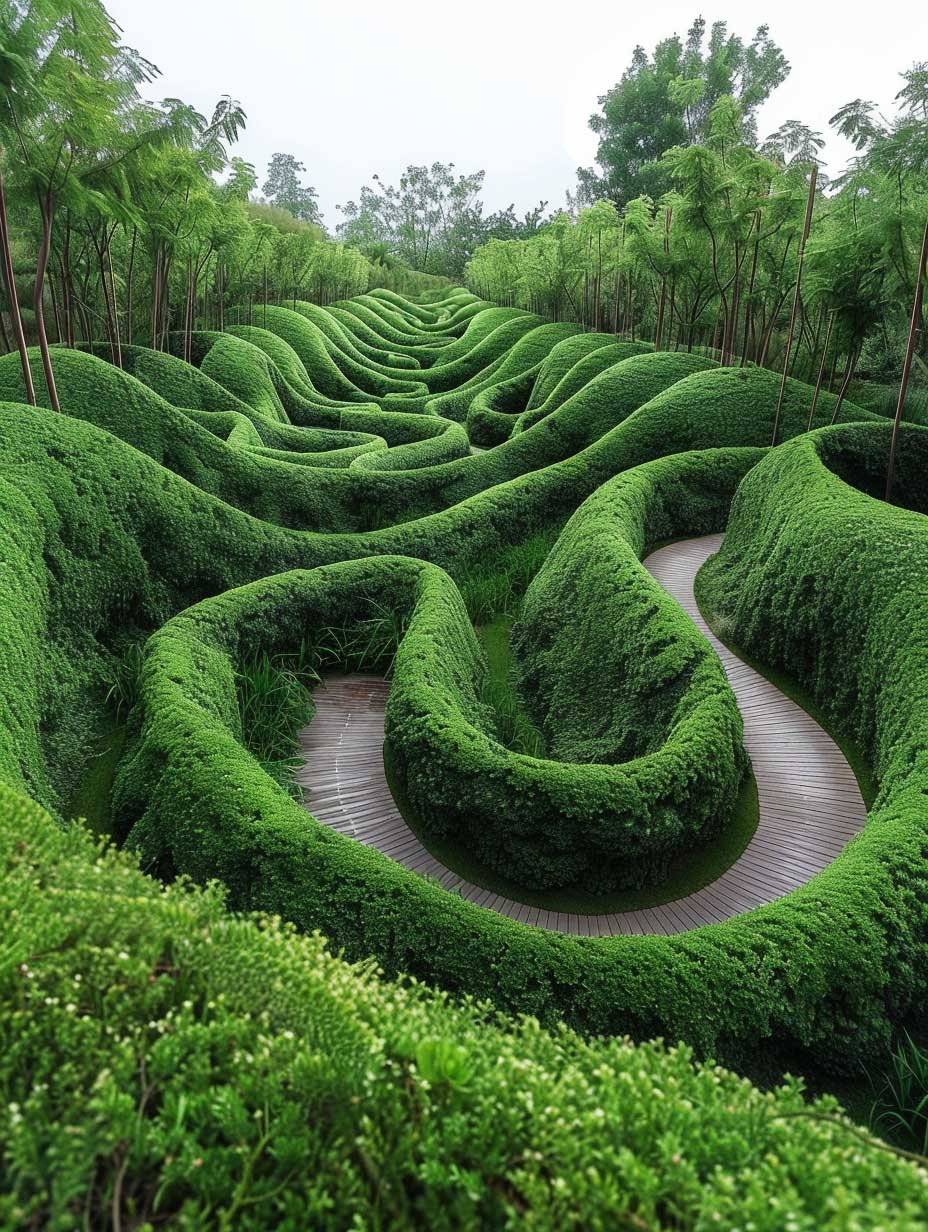
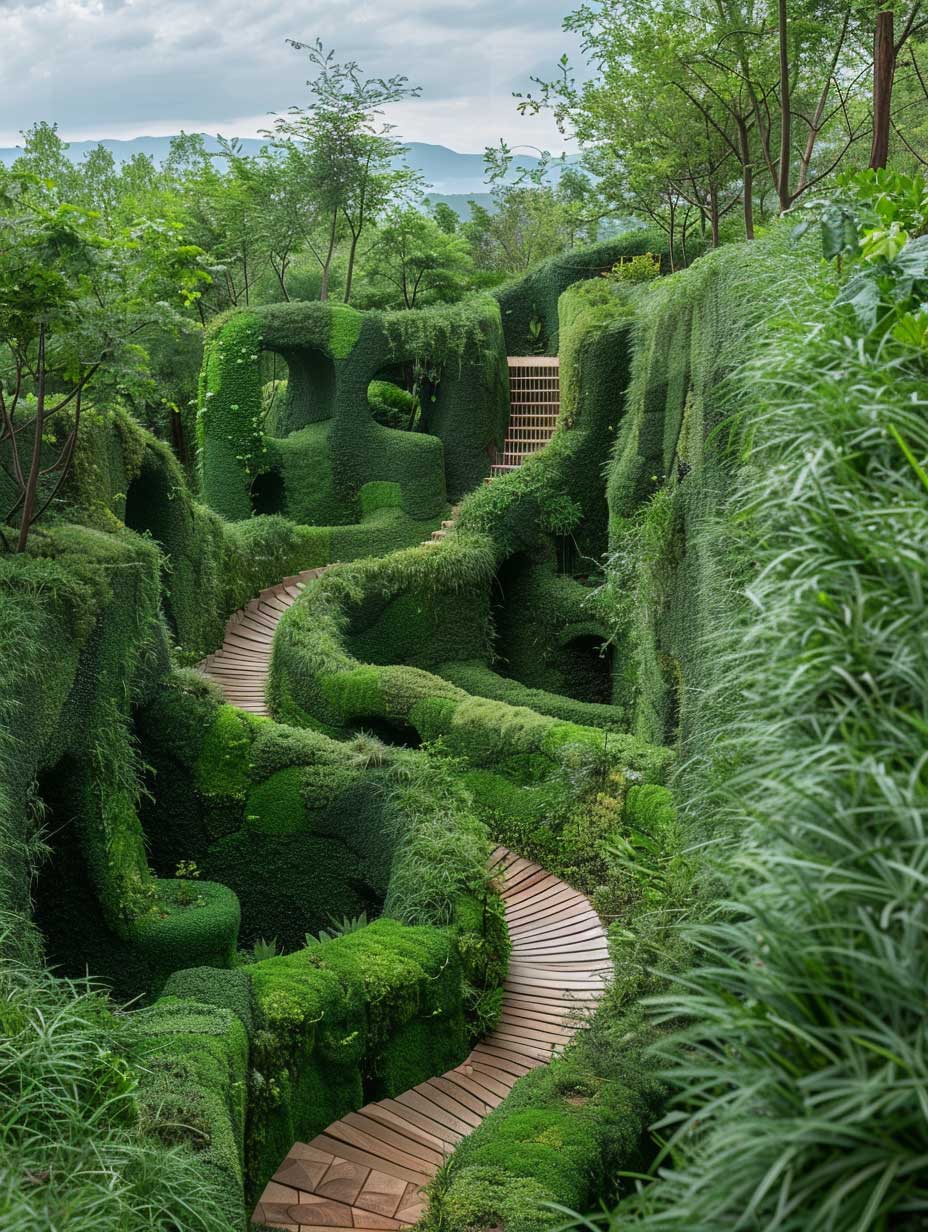
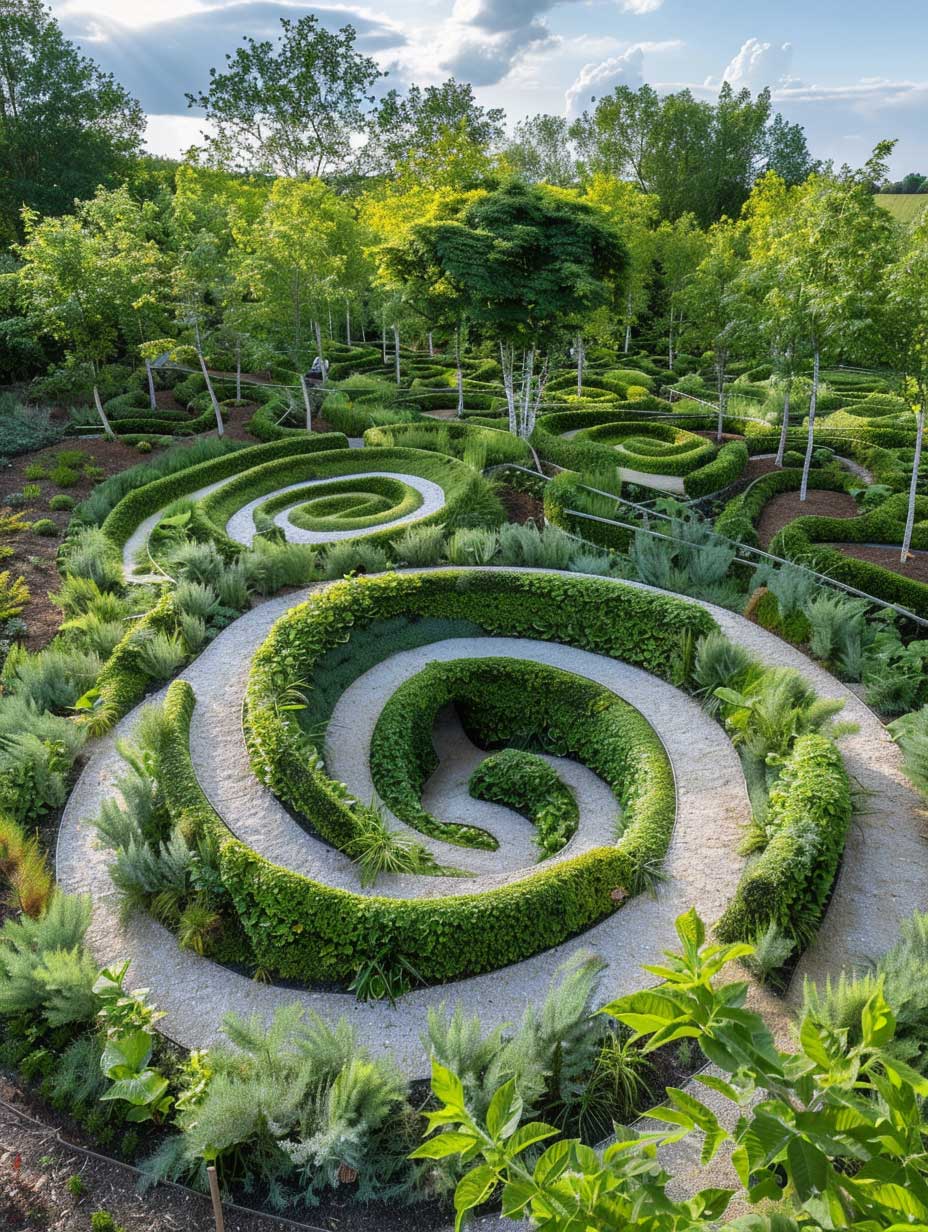
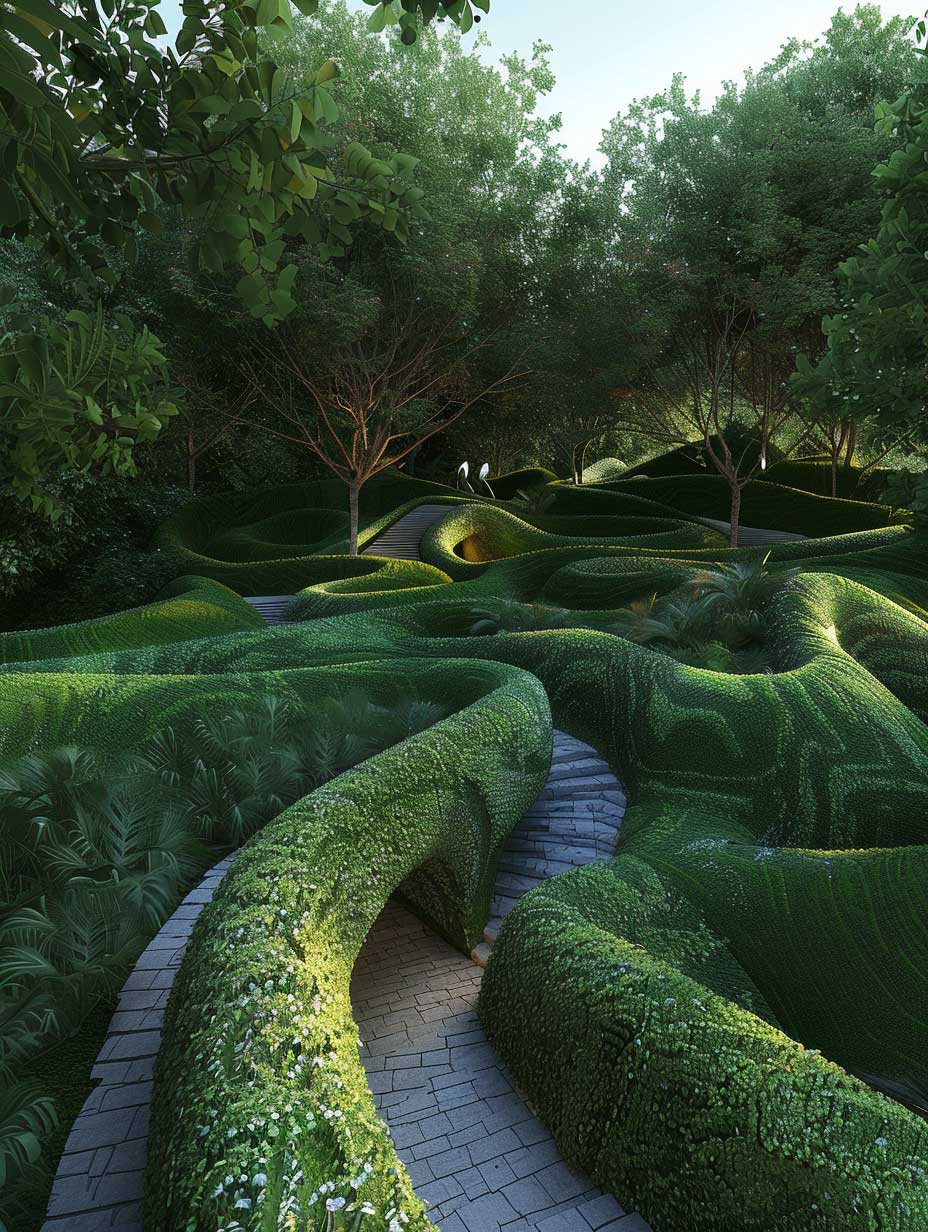
The green maze, with its emphasis on exploration and discovery, is emblematic of modern garden design’s shift towards spaces that are not only to be seen but experienced. It challenges the notion of passivity in garden visits, inviting active participation and engagement with the environment. This approach extends to the educational aspect of the garden, with signage and guides providing insights into the plants used in the maze, the principles of sustainable design, and the concept behind the maze’s creation.
The integration of the green maze into the garden landscape is a bold statement on the possibilities of combining sculpture with living elements. It stands as a testament to the creativity and innovation that define modern garden design, pushing the boundaries of what a garden can be. This living sculpture, constantly growing and changing, symbolizes the dynamic relationship between humans and nature, a relationship that is nurtured and celebrated within the confines of the garden.
As the seasons change, so too does the maze, offering a new experience with each visit. This ever-evolving nature highlights the garden’s commitment to sustainability and adaptability, key tenets of modern garden design. The green maze, in its complexity and beauty, serves as a powerful reminder of the role of gardens as spaces for environmental stewardship, creativity, and personal discovery.
In this garden, the green maze is more than a pathway or a puzzle to be solved—it is a journey through form, an invitation to lose oneself in the beauty of nature, and a challenge to engage with the environment in a meaningful way. It exemplifies the essence of modern garden design, where the boundaries between art, architecture, and horticulture blur, creating spaces that inspire, educate, and delight.
Integrating sculptural elements into modern garden design is more than just a trend; it is a sophisticated approach to garden landscaping that enriches the sensory experience of the space. Through the thoughtful placement of sculptures, gardens transform into galleries under the open sky, where every visit offers a new perspective. This integration not only celebrates the harmony between art and nature but also elevates the garden from a mere viewing space to an immersive experience, inviting visitors to interact with and reflect on the environment around them.

